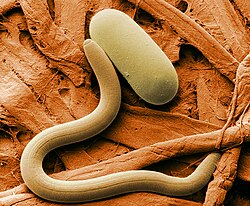Microfauna (Ancient Greek mikros "small" + Neo-Latin fauna "animal") refers to microscopic animals and organisms that exhibit animal-like qualities, and have body sizes that are usually <0.1mm.[1][2] Microfauna are represented in the animal kingdom (e.g. nematodes, small arthropods) and the protist kingdom (i.e. protozoans).

Habitat edit
Microfauna are present in every habitat on Earth. They fill essential roles as decomposers and food sources for lower trophic levels, and are necessary to drive processes within larger organisms. Populations of microfauna can reach up to ~107 (~10,000,000) individuals g−1 (0.1g, or 1/10th of a gram), and are very common in plant litter, surface soils, and water films.[3]
Role edit
One particular example of the role of microfauna can be seen in soil, where they are important in the cycling of nutrients in ecosystems.[4] The ecological functions of the rhizosphere can be influenced by microfauna, specifically by nematodes and protozoa who are abundant in soil. For instance, the carbon cycling within the soil can be affected by nematodes who will feed on the roots of plants, impacting the organic carbon in the soil. Soil micro-fauna can also impact microorganisms within the rhizosphere by affecting their diversity and accelerating microorganism turnover. This happens because of the microfauna's selective grazing and their ability to influence the resources within the soil.[5] Soil microfauna are capable of digesting just about any organic substance, and some inorganic substances.[citation needed] These organisms are often essential links in the food chain between primary producers and larger species. For example, zooplankton are widespread microscopic animals and protists that feed on algae and detritus in the ocean, such as foraminifera.
Microfauna also aid in digestion and other processes in larger organisms.
Cryptozoa edit
The microfauna are the least understood of soil life, due to their small size and great diversity. Many microfauna are members of the so-called cryptozoa, animals that remain undescribed by science. Out of the estimated 10-20 million animal species in the world, only 1.8 million have been given scientific names, and many of the remaining millions are likely microfauna, much of it from the tropics.
Phyla edit
Notable phyla include:
- Microscopic arthropods, including dust mites, spider mites, and some crustaceans such as copepods and certain cladocera.
- Tardigrades ("water bears")
- Rotifers, which are filter feeders that are usually found in fresh water.
- Some nematode species[6]
- Many loricifera, including the recently discovered anaerobic species, which spend their entire lives in an anoxic environment.[7][8]
See also edit
References edit
- ^ Dettwyler, Katherine A. (2011). Cultural anthropology & human experience : the feast of life. Long Grove, IL. ISBN 9781577666813. OCLC 706024344.
- ^ Fernández-Luqueño, Fabián; Vázquez-Núñez, Edgar; Pérez-Hernandez, Hermes (2023-01-01), La Rosa, Guadalupe De; Peralta-Videa, Jose R. (eds.), "Chapter 4 - Biophysicochemical transformations of ENMs in soil", Physicochemical Interactions of Engineered Nanoparticles and Plants, Nanomaterial-Plant Interactions, vol. 4, Academic Press, pp. 89–114, ISBN 978-0-323-90558-9, retrieved 2024-02-13
- ^ Haynes, Richard John (2014-01-01), Sparks, Donald (ed.), "Chapter Two - Nature of the Belowground Ecosystem and Its Development during Pedogenesis", Advances in Agronomy, vol. 127, Academic Press, pp. 43–109, doi:10.1016/b978-0-12-800131-8.00002-9, retrieved 2024-02-10
- ^ Aescht, E; Foissner, W (1996). "Microfauna". In Schinner, F; Öhlinger, R; Kandeler, E; Margesin, R (eds.). Methods in Soil Biology. Berlin, Heidelberg: Springer. doi:10.1007/978-3-642-60966-4_22.
- ^ Chen, Xiaoyun; Liu, Manqiang; Hu, Feng; Mao, Xiaofang; Li, Huixin (2007-08-01). "Contributions of soil micro-fauna (protozoa and nematodes) to rhizosphere ecological functions". Acta Ecologica Sinica. 27 (8): 3132–3143. doi:10.1016/S1872-2032(07)60068-7. ISSN 1872-2032.
- ^ "Microscopic Animals". Natural Recources Conservation Service. Archived from the original on 2010-03-05. Retrieved 2010-04-16.
- ^ Fang, Janet (6 April 2010). "Animals thrive without oxygen at sea bottom". Nature. 464 (7290): 825. doi:10.1038/464825b. PMID 20376121.
- ^ "Briny deep basin may be home to animals thriving without oxygen". Science News. 9 April 2010.